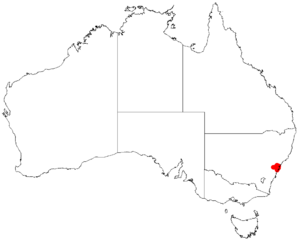Darwinia biflora facts for kids
Quick facts for kids Darwinia biflora |
|
|---|---|
| Conservation status | |
| Scientific classification | |
| Genus: |
Darwinia
|
| Species: |
biflora
|
 |
|
| Occurrence data from AVH | |
The Darwinia biflora is a special plant that belongs to the myrtle family, called Myrtaceae. It grows only in New South Wales, Australia, which means it is endemic there.
This plant is usually a shrub that stands upright, sometimes looking a bit straggly. It has flat, smooth leaves. Its flowers are quite unique, often growing in pairs. They are mostly greenish, but they have two pretty purple-red leaf-like parts around them. A long, yellow-green part, called a style, sticks out from the flower. You can find this plant only in the Sydney area, in specific spots where rocky ridges meet sandy areas.
Contents
What Does It Look Like?
The Darwinia biflora is a shrub that can grow from about 20 centimeters to 80 centimeters tall. Its leaves are smooth and grow in a special pattern, opposite each other and at right angles to the next pair. These leaves are about 6 to 10 millimeters long and often lie flat against the branches.
The flowers usually grow in pairs near the ends of the branches. When they open, they are shaped like a tube. The top part of the flower can be white or pink, while the tube part is green. The flower tube is about 5 to 8 millimeters long. Around the flower, there are small, leaf-like parts called bracts, which are 1 to 8 millimeters long. There are also two purple-red bracteoles, about 5 to 8 millimeters long, that fall off after the flower opens.
Inside the flower tube are the stamens (male parts) and staminodes (parts that look like stamens but don't work). A long, yellow-green or red part called the style sticks out of the tube. It's usually straight or slightly curved and can be 10 to 14 millimeters long.
This plant flowers all year round, but you'll see most of its blooms between May and August. After flowering, it produces a small, nut-like fruit, about 1 to 1.5 millimeters wide.
How Was It Named?
The first time this plant was officially described was in 1922 by a scientist named Edwin Cheel. He first called it Darwinia taxifolia var. biflora.
Later, in 1962, another scientist named Barbara Briggs decided it was special enough to be its own species. She changed its name to Darwinia biflora.
The name biflora comes from two Latin words: "bi-", which means "two", and "flos", which means "flower". This name perfectly describes how its flowers usually grow in pairs!
Where Does It Grow?
Even though some old plant samples show it might have grown in more places, today, all the known Darwinia biflora plants are found in the city areas of Sydney. You can find them between Maroota and North Ryde.
It likes to grow in open, shrubby areas on top of sandstone ridges. It also grows in woodlands where the sandy soil mixes with shale rock. About 90 of the 240 known places where this plant lives are in national parks or other protected areas. However, many other places where it grows are often chosen for building houses.
How Does It Live?
Scientists believe that individual Darwinia biflora plants can live for about 15 to 20 years. These plants usually pollinate themselves, meaning they don't need insects to carry pollen from one flower to another very often. In fact, insects are rarely seen visiting their flowers.
The plants usually start producing seeds when they are about 5 years old. Even though fire can kill the adult plants, many new seedlings often sprout up after a fire. This helps the species survive and grow back.
Is It Protected?
Yes, the Darwinia biflora is considered a vulnerable species. This means it needs protection. It is listed as vulnerable in New South Wales and also under the Australian Government's Environment Protection and Biodiversity Conservation Act 1999. This law helps protect plants and animals that are at risk.


